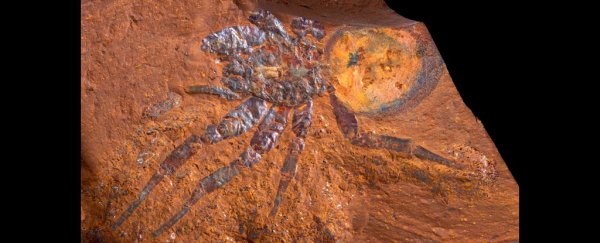The arid heart of Australia may not easily support life now, but once, many aeons ago, it was lush and teeming. What is now arid desert and dry shrub- and grasslands was once thick with dense forests, alive with life.
In one of these grasslands, in the Central Tablelands of NSW, paleontologists have found new evidence of this abundance of life. A new fossil site that can most aptly be described as "exceptional" has turned up fossils of spiders, insects, fish, plants and even a bird feather, dating to the Miocene 11 to 16 million years ago.
"The fossils we have found prove that the area was once a temperate, mesic rainforest and that life was rich and abundant here in the Central Tablelands, NSW," said paleontologist Matthew McCurry from the Australian Museum Research Institute.
"Many of the fossils that we are finding are new to science and include trapdoor spiders, giant cicadas, wasps and a variety of fish. Until now it has been difficult to tell what these ancient ecosystems were like, but the level of preservation at this new fossil site means that even small fragile organisms like insects turned into well-preserved fossils."
 Plant fossils from McGraths Flat. (McCurry et al., Sci. Adv., 2022)
Plant fossils from McGraths Flat. (McCurry et al., Sci. Adv., 2022)
The assemblage, named McGraths Flat, is so exceptional that it has been classified as a Lagerstätte – a sedimentary fossil bed that's so extraordinary that sometimes even soft tissues have been preserved. In McGraths Flat, organisms have been so well preserved that even subcellular structures can be made out in some fossils.
Even more amazingly, it's a type of rock in which exceptional fossils are not usually seen, an iron-rich rock called goethite.
"We think that the process that turned these organisms into fossils is key to why they are so well preserved," McCurry said. "Our analyses suggest that the fossils formed when iron-rich groundwaters drained into a billabong, and that a precipitation of iron minerals encased organisms that were living in or fell into the water."
The fossils in the assemblage bear a resemblance to the ecosystems in modern Australian rainforests, the researchers said, but it's the fine details that really make a difference.
For instance, subcellular structures called melanosomes that give tissues their pigment have been preserved in the site's fossilized feather and also in the eyes of a fish and a fly.
 The feather fossil. (Michael Frese)
The feather fossil. (Michael Frese)
Although the melanosomes themselves are unpigmented, their structure can be compared to the structure of modern melanosomes to help figure out how the tissues might have been hued. This allows the researchers to figure out what colors the various McGraths flat animals were, including the feather.
"The fossils also preserve evidence of interactions between species," said microbiologist Michael Frese of the University of Canberra.
"For instance, we have fish stomach contents preserved in the fish, meaning that we can figure out what they were eating. We have also found examples of pollen preserved on the bodies of insects so we can tell which species were pollinating which plants."
 Animal fossils from McGraths Flat. (McCurry et al., Sci. Adv., 2022)
Animal fossils from McGraths Flat. (McCurry et al., Sci. Adv., 2022)
Soberingly, the fossils also might contain a hint of what's in store for our future.
According to an analysis of the pollen grains in the assemblage, the McGraths Flat rainforest was being encroached upon by arid climate areas. This is not unexpected; during the Miocene, global temperatures had started to rise; it was during this period that the Australian continent started to transform from lush to arid.
Since global mean temperatures are rising, the ecosystem found in McGraths Flat could show us how life might change in Australia's current rainforests in the years to come.
"The McGraths Flat plant fossils give us a window into the vegetation and ecosystems of a warmer world, one that we are likely to experience in the future," said botanist David Cantrill of the Royal Botanic Gardens Victoria in Australia.
"The preservation of the plant fossils is unique and provides important insights into a time period for which the fossil record in Australia is rather poor."
The research has been published in Science Advances.
